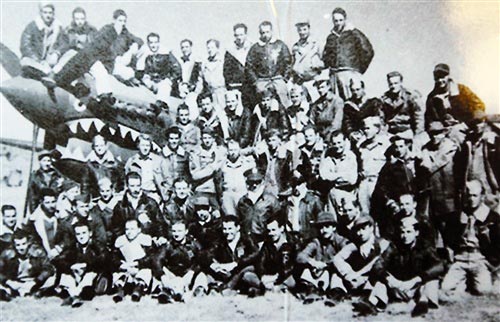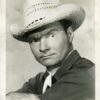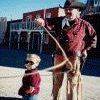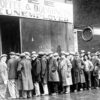The flying Tigers

![]()
Flying Tigers
From Wikipedia, the free encyclopedia
Jump to navigationJump to search
This article is about the World War II aviation unit. For other uses, see Flying Tigers (disambiguation).
| 1st American Volunteer Group | |
|---|---|
| Flying Tigers personnel | |
| Active | April 1941 – 4 July 1942 Became China Air Task Force in July 1942 |
| Country | |
| Allegiance | |
| Type | Fighter pilot group |
| Size | 3 squadrons; 60 aircraft average |
| Nickname(s) | The Flying Tigers |
| Commanders | |
| Notable commanders | Claire Chennault |
US Air Forces video: Flying Tigers Bite Back
The First American Volunteer Group (AVG) of the Republic of China Air Force, nicknamed the Flying Tigers, was formed to help oppose the Japanese invasion of China. Operating in 1941–1942, it was composed of pilots from the United States Army Air Corps (USAAC), Navy (USN), and Marine Corps (USMC), and was commanded by Claire Lee Chennault. Their Curtis P-40B Warhawk aircraft, marked with Chinese colors, flew under American control. Recruited under President Franklin Roosevelt’s authority before Pearl Harbor, their mission was to bomb Japan and defend the Republic of China, but many delays meant the AVG first flew in combat after the US and Japan declared war.
The group consisted of three fighter squadrons of around 30 aircraft each that trained in Burma before the American entry into World War II to defend the Republic of China against Japanese forces. The AVG were officially members of the Republic of China Air Force. The group had contracts with salaries ranging from $250 a month for a mechanic to $750 for a squadron commander, roughly three times what they had been making in the U.S. forces. While it accepted some civilian volunteers for its headquarters and ground crew, the AVG recruited most of its staff from the U.S. military.
The Flying Tigers began to arrive in China in April 1941. The group first saw combat on 20 December 1941, 12 days after Pearl Harbor (local time). It demonstrated innovative tactical victories when the news in the U.S. was filled with little more than stories of defeat at the hands of the Japanese forces, and achieved such notable success during the lowest period of the war for both the U.S. and the Allied Forces as to give hope to America that it might eventually defeat Japan. AVG pilots earned official credit and received combat bonuses for destroying 296 enemy aircraft, while losing only 14 pilots in combat.[1] The combat records of the AVG still exist and researchers have found them credible.[2] On 4 July 1942 the AVG was disbanded and replaced by the 23rd Fighter Group of the United States Army Air Forces, which was later absorbed into the U.S. Fourteenth Air Force with General Chennault as commander. The 23rd FG went on to achieve similar combat success, while retaining the nose art on the left-over P-40s.
Contents
- 1Origin
- 2Combat history
- 3Assessment of the AVG
- 4Members of the AVG
- 5Legacy
- 6Suggested Revival
- 7See also
- 8References
- 9External links
Origin[edit]
Chennault in his Kunming office, May 1942. He wears a US Army brigadier general’s star on his left shoulder but Chinese insignia otherwise.
The American Volunteer Group was largely the creation of Claire L. Chennault, a retired U.S. Army Air Corps officer who had worked in China since August 1937, first as military aviation advisor to Generalissimo Chiang Kai-shek in the early months of the Sino-Japanese War, then as director of a Chinese Air Force flight school centered in Kunming. Meanwhile, the Soviet Union supplied fighter and bomber squadrons to China, but these units were mostly withdrawn by the summer of 1940. Chiang then asked for American combat aircraft and pilots, sending Chennault to Washington as an adviser to China’s ambassador and Chiang’s brother-in-law, T. V. Soong.[3]
Chennault spent the winter of 1940–1941 in Washington, supervising the purchase of 100 Curtiss P-40 fighters and the recruiting of 100 pilots and some 200 ground crew and administrative personnel that would constitute the 1st AVG. He also laid the groundwork for a follow-on bomber group and a second fighter group, though these would be aborted after the Pearl Harbor attack.
Original American volunteer group[edit]
3rd Squadron Hell’s Angels, Flying Tigers, over China, photographed in 1942 by AVG pilot Robert T. Smith
P-40 Warhawk painted with Flying Tigers shark face at the National Museum of the United States Air Force
Of the pilots, 60 came from the Navy and Marine Corps and 40 from the Army Air Corps. (One army pilot, Albert Baumler was refused a passport because he had earlier flown as a mercenary in Spain, so only 99 actually sailed for Asia. Ten more army flight instructors were hired as check pilots for Chinese cadets, and several of these would ultimately join the AVG’s combat squadrons.) The volunteers were discharged from the armed services, to be employed for “training and instruction” by a private military contractor, the Central Aircraft Manufacturing Company (CAMCO), which paid them $600 a month for pilot officers, $675 a month for flight leaders, $750 for squadron leaders (no pilot was recruited at this level), and about $250 for skilled ground crewmen. Some pilots were also orally promised a bounty of $500 for each enemy aircraft shot down, and this was later confirmed by Madame Chiang Kai-shek.[4]
Resignation letter from the U.S. Marine Corps, used to accept a position with the Central Aircraft Manufacturing Co.
The first batch, some 300 men, departed San Francisco on 10 July 1941 and arrived in Rangoon, Burma on 28 July,[5][6] via the Dutch ship Jaegersfontaine, operated by Java-Pacific Lijn.[7] The second batch, some 30 pilots, departed on 24 September 1941 and arrived on 12 November 1941 via the Dutch ship Boschfontein.[8] These volunteers used civilian passports in these trips. After arriving in Rangoon, they were initially based at a British airfield in Toungoo for training while their aircraft were assembled and test flown by CAMCO personnel at Mingaladon Airport outside Rangoon.[9] Chennault set up a schoolhouse that was made necessary because many pilots had “lied about their flying experience, claiming pursuit experience when they had flown only bombers and sometimes much less powerful aeroplanes.”[9] They called Chennault “the Old Man” due to his much older age and leathery exterior obtained from years flying open cockpit pursuit aircraft in the Army Air Corps. Most believed that he had flown as a fighter pilot in China, although stories that he was a combat ace are probably apocryphal.[10]
Of the 300 original members of the CAMCO personnel, 9 were Chinese-Americans recruited from America’s Chinatowns. All 9 were trained at Allison Engineworks in Indianapolis, Indiana: all were P-40 mechanics. Upon arrival in Kunming, 2 other Chinese-Americans were hired, a Ford Motor truck specialist and a doctor. Total original Chinese-Americans were 11. Prior to 4 July 1942, 3 of the P-40 mechanics resigned. The official AVG roster lists the original 8.[citation needed]
The AVG was created by an executive order of Generalissimo Chiang Kai-shek. He did not speak English, however, and Chennault never learned to speak Chinese. As a result, all communications between the two men were routed through Soong Mei-ling, “Madame Chiang” as she was known to Americans, and she was designated the group’s “honorary commander.”
Chennault fighter doctrine[edit]
Chennault preached a radically different approach to air combat based on his study of Japanese tactics and equipment, his observation of the tactics used by Soviet pilots in China, and his judgment of the strengths and weaknesses of his own aircraft and pilots. The actual average strength of the AVG was never more than 62 combat-ready pilots and fighters. Chennault faced serious obstacles since many AVG pilots were inexperienced and a few quit at the first opportunity. However, he made a virtue out of these disadvantages, shifting unsuitable pilots to staff jobs and always ensuring that he had a squadron or two in reserve. (The AVG had no ranks, so no division between officers and enlisted soldiers existed.[11])
Chennault and the Flying Tigers benefited from the country’s warning network, called “the best air-raid warning system in existence”:[11]
Starting from areas in Free China, in hundreds of small villages, in lonely outposts, in hills and caves, stretching from near Canton through all Free China to the capital in Chungking and to Lanchow, far northwest, are a maze of alarm stations equipped with radios and telephones that give instant warning of the approach of Japanese planes.[11]
When Japanese aircraft attacked, Chennault’s doctrine called for pilots to take on enemy aircraft in teams from an altitude advantage, since their aircraft were not as maneuverable or as numerous as the Japanese fighters they would encounter. He prohibited his pilots from entering into a turning fight with the nimble Japanese fighters, telling them to execute a diving or slashing attack and to dive away to set up for another attack. This “dive-and-zoom” technique was contrary to what the men had learned in U.S. service as well as what the Royal Air Force (RAF) pilots in Burma had been taught; it had been used successfully, however, by Soviet units serving with the Chinese Air Force.[12]
Curtiss P-40[edit]
Main article: Curtiss P-40
1943: A Kittyhawk Mark III of 112 Squadron, taxiing through scrub at Medenine, Tunisia. The ground crewman on the wing is directing the pilot, whose view ahead is hindered by the aircraft’s nose.
A ZG 76 Bf 110C with “sharks mouth” nose paint
AVG fighter aircraft came from a Curtiss assembly line which had just started producing Tomahawk IIB models for the Royal Air Force in North Africa. The Tomahawk IIB was similar to the U.S. Army’s P-40C, but there is some evidence that Curtiss actually used leftover components when building the fighters intended for China, making them closer to the older P-40B/Tomahawk IIA specification – for instance the AVG aircraft had fuel tanks with external self-sealing coatings, rather than the more effective internal membranes as fitted to the P-40C/Tomahawk IIB, and the aircraft built for China lacked the later Tomahawk’s fittings to carry a drop tank and the addition of an armour plate in front of the pilot.[13] The fighters were purchased without “government-furnished equipment” such as reflector gunsights, radios and wing guns; the lack of these items caused continual difficulties for the AVG in Burma and China.
The 100 P-40 aircraft were crated and sent to Burma on third country freighters during spring 1941. At Rangoon, they were unloaded, assembled and test flown by personnel of Central Aircraft Manufacturing Company (CAMCO) before being delivered to the AVG training unit at Toungoo.[14] One crate was dropped into the water and a wing assembly was ruined by salt water immersion, so CAMCO was able to deliver only 99 Tomahawks before war broke out. (Many of those were destroyed in training accidents.) The 100th fuselage was trucked to a CAMCO plant in Loiwing, China, and later made whole with parts from damaged aircraft. Shortages in equipment, with spare parts almost impossible to obtain in Burma (along with the slow introduction of replacement fighter aircraft), were continual impediments, although the AVG did receive 50 replacement P-40E fighters from USAAF stocks toward the end of its combat tour.
AVG fighter aircraft were painted with a large shark face on the front of the aircraft. This was done after pilots saw a photograph of a P-40 of No. 112 Squadron RAF in North Africa,[15] which in turn had adopted the shark face from German pilots of the Luftwaffe’s ZG 76 heavy fighter wing, flying Messerschmitt Bf 110 fighters in Crete. (The AVG nose-art is variously credited to Charles Bond[16] and Erik Shilling.) About the same time, the AVG was dubbed “The Flying Tigers” by its Washington support group, called China Defense Supplies.[17] The P-40’s good qualities included pilot armor, self-sealing fuel tanks, sturdy construction, heavy armament, and a higher diving speed than most Japanese aircraft – qualities that could be used to advantage in accordance with Chennault’s combat tactics.[18] Chennault created an early warning network of spotters that would give his fighters time to take off and climb to a superior altitude where this tactic could be executed.[19]
Combat history[edit]
| This section needs additional citations for verification. Please help improve this article by adding citations to reliable sources. Unsourced material may be challenged and removed. (December 2012) (Learn how and when to remove this template message) |
The port of Rangoon in Burma and the Burma Road leading from there to China were of crucial importance. Eastern China was under Japanese occupation, so all military supplies for China arrived via the Burma route. By November 1941, when the pilots were trained and most of the P-40s had arrived in Asia, the Flying Tigers were divided into three squadrons: 1st Squadron (“Adam & Eves”); 2nd Squadron (“Panda Bears”) and 3rd Squadron (“Hell’s Angels”).[9] They were assigned to opposite ends of the Burma Road to protect this vital line of communications. Two squadrons were based at Kunming in China, and a third at Mingaladon Airport near Rangoon. When the United States officially entered the war, the AVG had 82 pilots and 79 aircraft, although not all were combat-ready. Tiger Erik Shilling, part of the third squadron commented:. “This was the beginning of the greatest adventure I would ever hope to experience. It wasn’t until years later that I fully realized the magnitude and significance of this first step, to be a lifelong adventure in the mystic Far East.”[20]
The AVG’s first combat mission was on 20 December 1941, when aircraft of the 1st and 2nd squadrons intercepted 10 unescorted Kawasaki Ki-48 “Lily” bombers of the 21st Hikōtai attacking Kunming. The bombers jettisoned their loads before reaching Kunming. Three of the Japanese bombers were shot down near Kunming and a fourth was damaged so severely that it crashed before returning to its airfield at Hanoi. Later, Chinese intelligence intercepted Japanese communications indicating that only 1 out of the 10 bombers ultimately returned to base. Furthermore, the Japanese discontinued their raids on Kunming while the AVG was based there. One P-40 crash-landed; it was salvaged for parts. This mission was one of the earliest American aerial victories in the Pacific War.
Defense of Rangoon[edit]
A “blood chit” issued to the American Volunteer Group Flying Tigers. The Chinese characters read, “This foreign person has come to China to help in the war effort. Soldiers and civilians, one and all, should rescue and protect him.” (R. E. Baldwin Collection)
The first squadron had flown up to Kunming to defend the terminus of the Burma Road and saw some combat action on 20 December 1941 while defending Rangoon from Japanese bombers, taking down four of them and disrupting their attack on the Burma Road.[21]
At this time, the focus of Japan’s offensive efforts in the AVG’s coverage area was southern Burma. The 3rd Squadron – 18 aircraft strong – defended Rangoon from 23 to 25 December. On 23 December, Mitsubishi Ki-21 “Sally” heavy bombers of the 60th, 62nd and 98th Sentai, along with single-engined Mitsubishi Ki-30 “Ann” attack bombers of the 31st Sentai, sortied against Rangoon. They were escorted by Nakajima Ki-27 “Nate” fighters of 77th Sentai. The Imperial Japanese Army Air Force (JAAF) formation was intercepted by the AVG and RAF Brewster Buffalos of 67 Squadron. Eight Ki-21s were shot down for the loss of three AVG P-40s. The 60th Sentai was particularly hard hit – it lost five out of the 15 bombers it had dispatched. Nevertheless, Rangoon and Mingaladon airfield were successfully bombed, with the city suffering more than 1,000 dead. Two Buffalos and two P-40s were destroyed on the ground, and one P-40 crashed when it attempted to land on a bomb-damaged runway.
On 25 December, the JAAF returned, reinforced by Ki-21s of 12th Sentai and Nakajima Ki-43 Hayabusas (Oscars) of the 64th Sentai (Colonel Tateo Katō‘s Flying Squadron). A total of 63 bombers escorted by 25 fighters were committed. These were intercepted by 14 P-40s of the AVG’s 3rd Squadron and 15 Buffalos of 67 Squadron. In the two encounters, 35 Japanese bombers and fighters were shot down. The Allies lost two pilots and five P-40s.[20] Mingaladon airfield was once again damaged, and eight Buffalos were destroyed on the ground.
After its losses in the 23–25 December battles, the 3rd Squadron was relieved by the 2nd Squadron “Panda Bears”, which carried out a series of raids on JAAF airbases in Thailand. The Japanese had moved aircraft to Malaya to finish off Singapore, and its remaining aircraft in the area (the 77th, 31st and 62nd Sentai) launched fighter sweeps and counter raids on the Allied airfield at Mingaladon.
On 12 January, the Japanese launched their Burma Campaign. Significantly outnumbered, the AVG was gradually reduced through attrition, but often exacted a disproportionate toll of their attackers. On 24 January, six Ki-21s of the 14th Sentai escorted by Ki-27s attacked Mingaladon. All the Ki-21s were shot down by the AVG and RAF defenders. On 28 January, a fighter sweep of 37 Ki-27s was engaged by 16 AVG P-40s and two RAF fighters. Three “Nates” were shot down for the loss of two P-40s. The next day, another sweep of 20 Ki-27s of the 70th Sentai was met by 10 Allied fighters (eight P-40s and two Hawker Hurricanes). Four were shot down for the loss of no Allied aircraft.
Despite these minor victories and Chennault’s reinforcement of the “Panda Bears” with pilots from the “Adam and Eves”, by mid-February, only 10 P-40s were still operational at Mingaladon. Commonwealth troops retreated before the Japanese onslaught, and the AVG was pressed into the ground attack role to support them. One unfortunate result of these missions was a prolonged air attack on a suspected Japanese column on 21 February that turned out to consist of Commonwealth troops. More than 100 Allied people died in this friendly fire incident. On 27 February, after hearing that the RAF was retreating and pulling out its radar equipment, the AVG withdrew to bases in northern Burma.
By 24 January, the Flying Tigers had destroyed 73 Japanese aircraft while losing only five themselves – a notable performance, considering the AVG was outnumbered and faced experienced and fully trained Japanese pilots. The main disadvantage of JAAF fighter pilots of this period was the near-obsolescence of their predominant fighter type in the theater, the Ki-27. Though more maneuverable than the P-40, its armament and performance was inferior. Lightly constructed and armed, it could not withstand frontal attacks nor could it out-dive Allied fighters such as the P-40; if it attempted to, it often came apart in the air. In fact, its cruising speed was less than that of the Ki-21 bombers it was intended to escort.[21]
Retreat into China[edit]
After Rangoon was lost to the Japanese at the end of February, the AVG relocated to Magwe, a small British airfield more than 300 miles north of Rangoon. Chennault started moving elements of the now reconstituted 3rd Squadron to Magwe as reinforcement to his worn down 1st and 2nd squadrons. Aircraft attrition became so high that at this point, individual squadron distinctions became meaningless, and all three squadrons had elements based there, along with a number of RAF aircraft. In total, the Allies had 38 aircraft, including eight P-40s and 15 Hawker Hurricanes. Opposing them were 271 Japanese aircraft, including 115 fighters. Although the AVG and the RAF scored some successes against the JAAF, Magwe was continuously bombed, including a very heavy raid on 21 March by 151 bombers and fighters. On 23 March with only four aircraft left, the AVG was forced to relocate to Loiwing, just across the Chinese border. The Tigers crossed into China on a rickety suspension bridge over a deep gorge. A few months later, they came back to destroy the bridge so no Japanese soldiers could come across that way into China.[22]

































![Lieutenant-Colonel Robert Rogers (7 November 1731 – 18 May 1795) was a British Army officer and frontiersman. Born in Methuen, Massachusetts, he fought in King George’s War, the French and Indian War and the American Revolutionary War. During the French and Indian War, Rogers raised and commanded Rogers’ Rangers, a ranger unit trained for carrying out asymmetric warfare.[2][3](https://www.cowboyron.com/wp-content/uploads/2022/05/1262463_580743685323360_2133853937_o1-1-150x150.jpg)
















![Billie Joe Armstrong & Norah Jones – Silver Haired Daddy Of Mine [Music Video]](https://www.cowboyron.com/wp-content/uploads/2022/11/Al_St._John1-100x100.jpg)

























